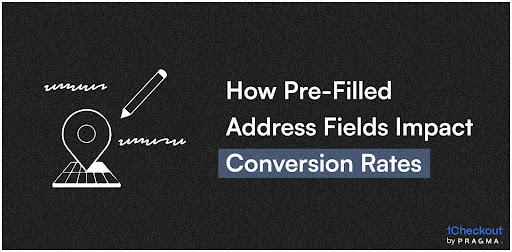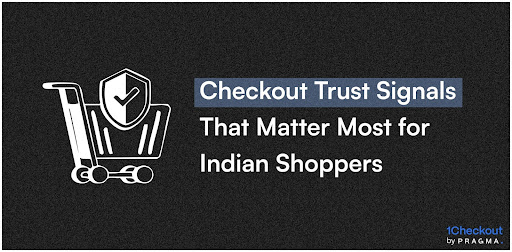As India’s e-commerce growth accelerates beyond metro hubs, Tier-2 and Tier-3 cities are emerging as critical battlegrounds for D2C brands. Yet, cart abandonment rates in these regions remain notably high, often due to complex checkout processes that fail to address the unique challenges and preferences of semi-urban and rural customers. To truly unlock the potential of these markets, brands need to rethink and redesign their checkout flows with a focus on simplicity, trust, and local relevance.
Comparative analysis of 347,000 checkout sessions across metro and non-metro markets reveals that interface patterns optimised for urban digital natives create systematic friction in markets with different connectivity infrastructure, device capabilities, digital literacy levels, and transaction preferences.
Tier-2 and Tier-3 customers abandon at payment method selection 2.3x more frequently than metro users, spend 47% longer at address entry without completing, and bounce from verification steps at 3.1x higher rates. These patterns signal fundamental UX misalignment rather than simple product-market fit gaps.
In this comprehensive guide on how to build a checkout flow that reduces cart abandonment in Tier-2 and Tier-3 cities, we're examining the infrastructure constraints, behavioural differences, and trust dynamics that demand distinct checkout architecture for non-metro markets. Brands implementing Tier-2/3-optimised checkout experiences report 58-67% improvement in conversion rates, 34-42% reduction in time-to-completion, and 89% increase in COD selection comfort through interfaces respecting regional market realities rather than imposing metro-centric assumptions.
Why do metro-optimised checkouts fail in smaller cities?
Infrastructure assumptions embedded in standard checkout flows become breaking points in connectivity-constrained markets
Network connectivity patterns differ fundamentally between metros and Tier-2/3 cities, affecting checkout completion feasibility. Mumbai 4G networks deliver 15-25 Mbps average speeds with 98% uptime, whilst Tier-3 cities experience 4-8 Mbps speeds with frequent drops to 3G during peak hours. Checkout flows loading multiple external scripts, high-resolution images, and real-time validation APIs that work seamlessly in metros time out or fail in bandwidth-constrained environments. The technical fragility manifests as frozen screens, unresponsive buttons, and error messages that customers interpret as checkout unavailability.
E-commerce checkout flows designed for metropolitan users often lead to high cart abandonment in Tier-2 and Tier-3 cities due to several key factors:
1. Device Capability Limitations:
- A significant majority (64-72%) of users in non-metro markets access e-commerce via entry-level smartphones with 2-3GB RAM, contrasting with 48-54% in metros.
- Checkout interfaces optimised for high-end devices with ample memory and processing power become slow or crash on these budget phones.
- Features like form auto-fill, address auto-complete, and interactive maps, which enhance the metro experience, either fail to load or cause crashes on resource-limited devices.
- This performance degradation results in abandonment not by choice, but because completing the transaction becomes technically impossible.
2. Divergent Payment Preferences:
- Payment infrastructure maturity varies considerably, with Tier-2/3 cities showing 45-52% lower digital wallet adoption and 38-44% less credit card penetration compared to metros.
- Checkout flows that prioritise UPI and cards, positioning Cash on Delivery (COD) as a fallback, misinterpret market preferences. In these regions, COD is often the primary payment method by customer choice, not an avoidance of digital payments.
- Such a hierarchy subtly signals brand assumptions that customers should transition to digital payments, creating psychological friction even when COD is available.
3. Language and English Proficiency Gaps:
- Standard checkouts often lack the interface flexibility needed to accommodate varying language preferences and English proficiency levels.
- While 78-84% of metro users are comfortable with English interfaces, only 42-51% of Tier-2/3 customers share this comfort.
- Checkouts that lack regional language options or provide poor translations force customers to navigate unfamiliar terminology while making financial commitments.
- This increased cognitive load complicates the checkout process, escalating abandonment rates even when customers genuinely intend to purchase.
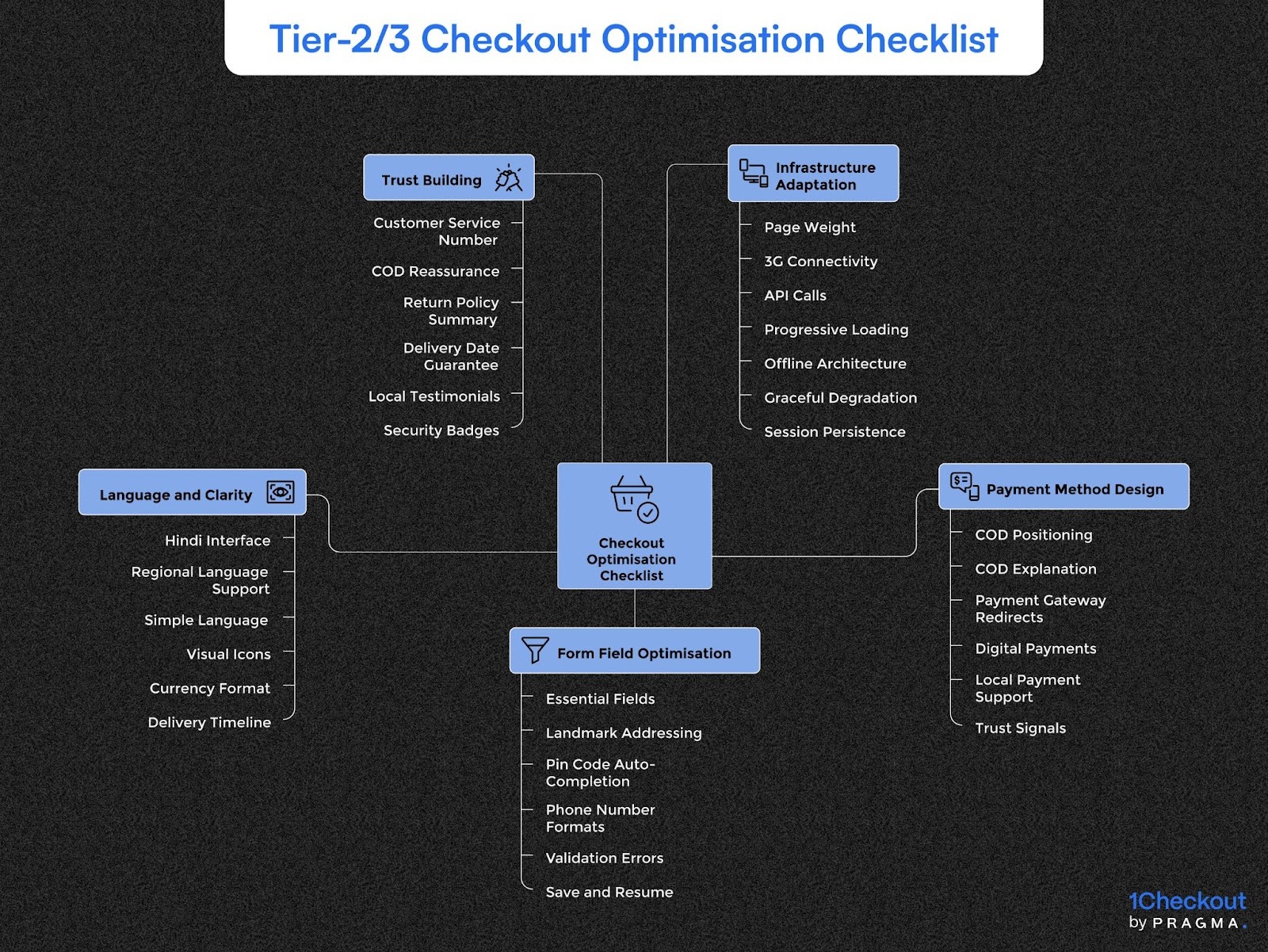
How should address collection differ for Tier-2 and Tier-3 markets?
Landmark-centric navigation patterns require input methods aligned with how customers conceptualise their locations
Formal address systems using flat numbers, street names, and building codes work well in planned metro areas but fail in organic Tier-2/3 growth where "near Hanuman temple, blue gate house" provides more actionable delivery information than "Plot 47, Sector 3." Checkout forms demanding structured address fields force customers to artificially fit landmark-based mental maps into postal-system categories. This translation burden creates abandonment as customers struggle to complete mandatory fields for address components that don't exist in their reality.
Pin code entry should trigger aggressive auto-completion of city, state, and area details minimising manual typing that's particularly burdensome on mobile keyboards in noisy environments. Tier-2/3 customers demonstrate 2.1-2.8x higher error rates in city name spelling compared to metro users, often due to transliteration uncertainty between regional languages and English. Automatic population eliminates these errors whilst dramatically reducing form completion time from 180-240 seconds to 60-90 seconds.
Landmark field prominence deserves elevation from optional "address line 3" to primary guidance field. Positioning landmark entry early in address flow—before or alongside house/flat number—signals that landmark-based directions are expected and valued. Including common landmark examples—"Near [Bank/Temple/School/Market]"—in placeholder text guides customers toward delivery-useful information. This reorientation aligns input structure with courier navigation realities in areas lacking formal address infrastructure.
Voice input capability for address entry reduces typing friction significantly in markets with lower typing proficiency. Enabling microphone-based address input—"Building next to State Bank, opposite Gupta Medical, main road"—captures location details naturally whilst avoiding spelling struggles and keyboard frustration. The voice-to-text conversion requires connectivity but operates on smaller data packets than continuous form interaction, making it viable even in constrained network environments.
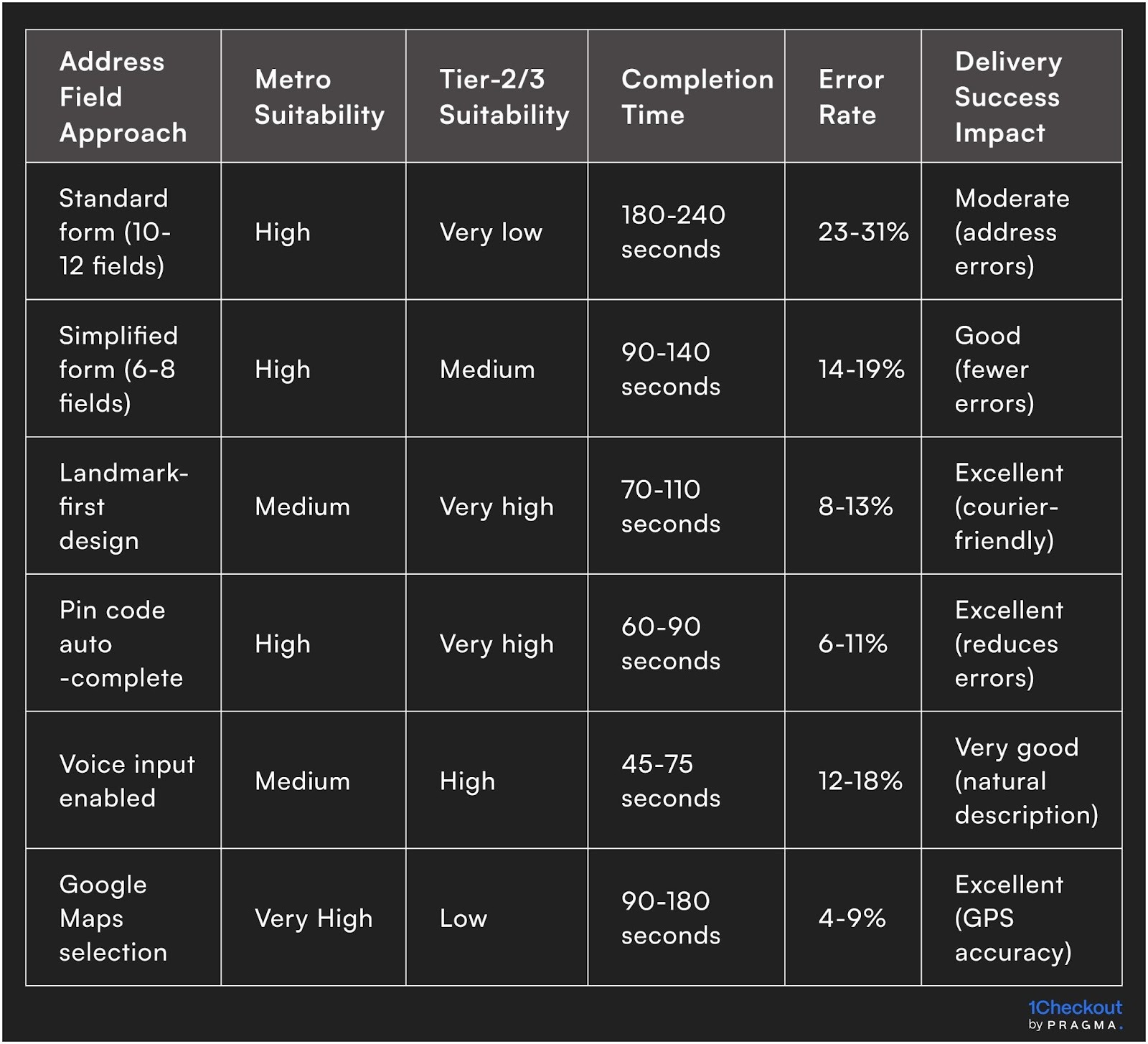
What payment psychology differs between metro and non-metro customers?
Trust calibration and financial decision-making patterns demand payment presentation matching regional comfort levels
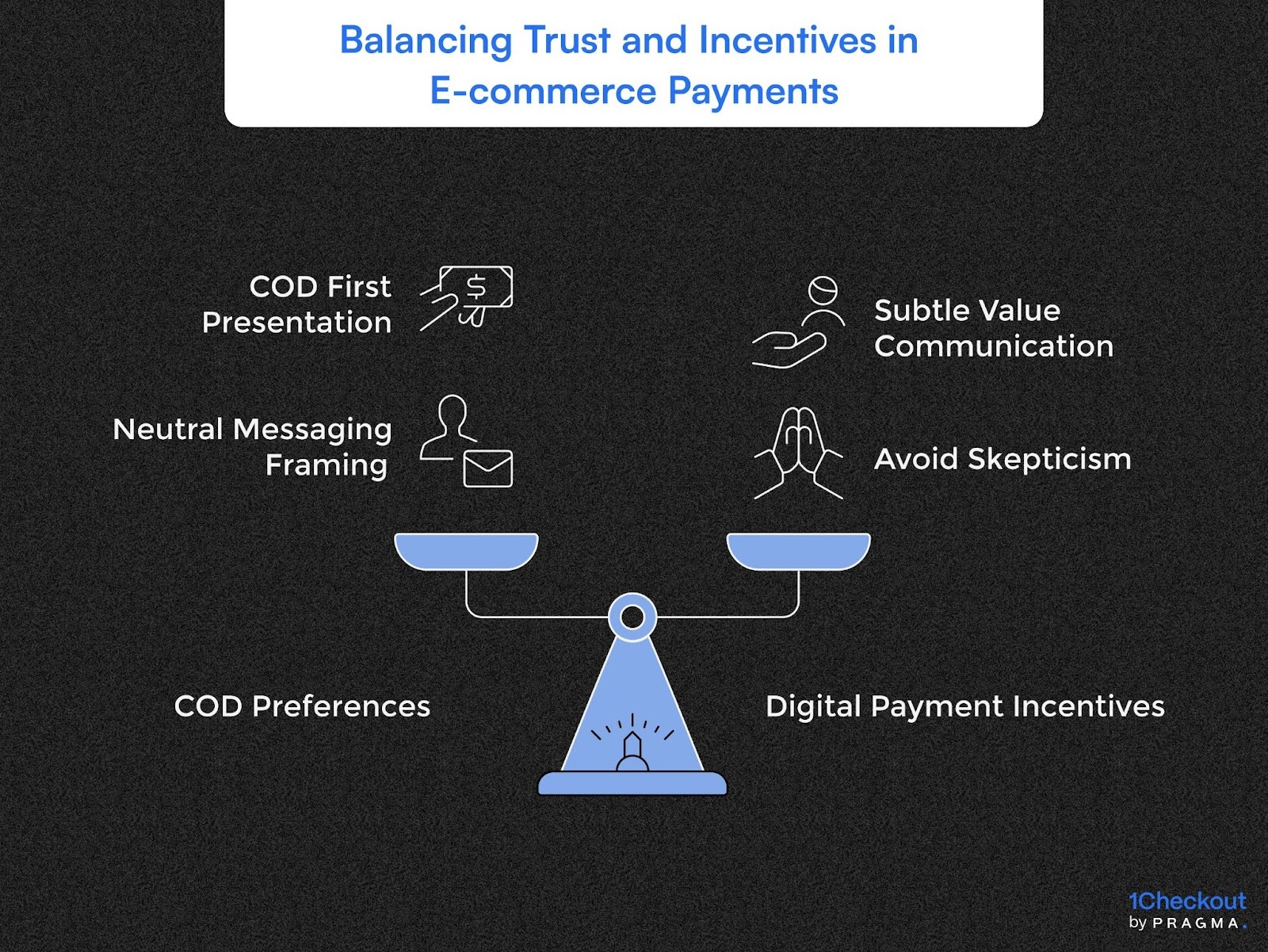
To effectively reduce cart abandonment in Tier-2 and Tier-3 cities, e-commerce checkout flows must address the unique preferences and concerns of customers in these markets, particularly regarding Cash on Delivery (COD) and digital payments.
Understanding COD Preferences:
In Tier-2 and Tier-3 cities, the preference for COD is often less about the inability to use digital payments and more about a perceived transaction risk. Customers frequently express concerns about:
- Product quality uncertainty: They want to verify the product before committing to payment.
- Delivery reliability doubts: They prefer to pay upon successful receipt of the item.
- Return process complexity: COD offers a simpler solution by deferring payment until satisfaction.
Treating COD as a mere "inconvenient legacy option" overlooks these legitimate trust gaps that a well-designed payment system should acknowledge and mitigate.
Optimising Payment Method Presentation:
The order in which payment options are displayed significantly influences customer choice, creating a psychological "anchoring effect."
- For Tier-2/3 markets: Reversing the typical hierarchy by placing COD first, followed by digital payment options (like UPI and cards), validates customer preferences. This approach acknowledges market realities without restricting choices for those who prefer digital methods.
- Current Metro practice: In contrast, metros often show UPI first, then cards, and COD last, implying a digital payment priority.
Framing COD Messaging:
The language used to present COD can significantly impact a customer's payment decision.
- Avoid negative framing: Many checkouts use language such as "₹40 COD charges apply" or "Prepaid orders ship faster," which can create a defensive mindset and make customers feel their choice is being discouraged.
- Adopt neutral or positive framing: Messaging like "Pay safely when you receive your order" or "Inspect product before payment" respects customer choice and eliminates adversarial dynamics. This linguistic shift ensures that brands appear to support, rather than resent, customer payment preferences.
Calibrating Digital Payment Incentives:
Promoting digital payments requires cultural sensitivity, as aggressive discount tactics can sometimes backfire in trust-sensitive markets.
- Avoid triggering skepticism: Messaging such as "Save ₹75 by paying now" might lead customers to question why the brand is so eager for advance payment, potentially fostering distrust rather than encouraging prepaid adoption.
- Communicate subtle value: A more effective approach is to position digital payments as access to benefits, for example, "Prepaid orders eligible for special offers." This reframing maintains the economic incentive without provoking psychological resistance, allowing customers to perceive digital payments as an added advantage rather than a compensation for distrust.
How can progressive disclosure reduce cognitive load?
Staged information revelation prevents overwhelming customers whilst maintaining completion pathway clarity
Single-screen checkout designs popular in metro contexts assume customer attention spans and form-filling confidence that don't translate to markets with lower e-commerce familiarity.
Tier-2/3 customers benefit from multi-step flows that break checkout into digestible stages:
delivery details → delivery preferences → payment selection → order review.
This segmentation creates psychological progress markers whilst preventing the paralysis that comprehensive single-screen forms induce. Each step completion generates accomplishment micro-rewards that sustain momentum through full flow.
Information hiding for optional or advanced features prevents distraction from essential completion path. Features like gift wrapping, delivery instructions, GST details, or alternative addresses that some customers need shouldn't appear prominently for all users. Implementing these as expandable sections or "Add special requests" links maintains clean primary flow whilst preserving advanced functionality. The progressive disclosure ensures sophisticated features don't create complexity penalties for straightforward purchases.
Help text and field explanations should appear contextually when customers need them rather than cluttering interface permanently. Hover tooltips, inline expansion on field focus, or small "?" icons providing guidance on-demand give customers control over information depth. This approach respects experienced users who don't need explanations whilst supporting first-time buyers encountering unfamiliar concepts like pin codes or GST numbers. The adaptability serves diverse customer sophistication levels within single interface.
Order review summary before final submission provides psychological comfort that particularly benefits less confident purchasers.
Displaying complete order details—products, delivery address, payment method, total amount—with clear "Edit" options for each section enables last-minute verification without restarting checkout. This confirmation stage prevents "submit anxiety" where customers fear making irreversible mistakes, building confidence that supports conversion rather than generating last-second abandonment.
What trust signals specifically resonate in Tier-2 and Tier-3 markets?
Credibility markers calibrated to regional risk perceptions build confidence that generic trust badges cannot generate
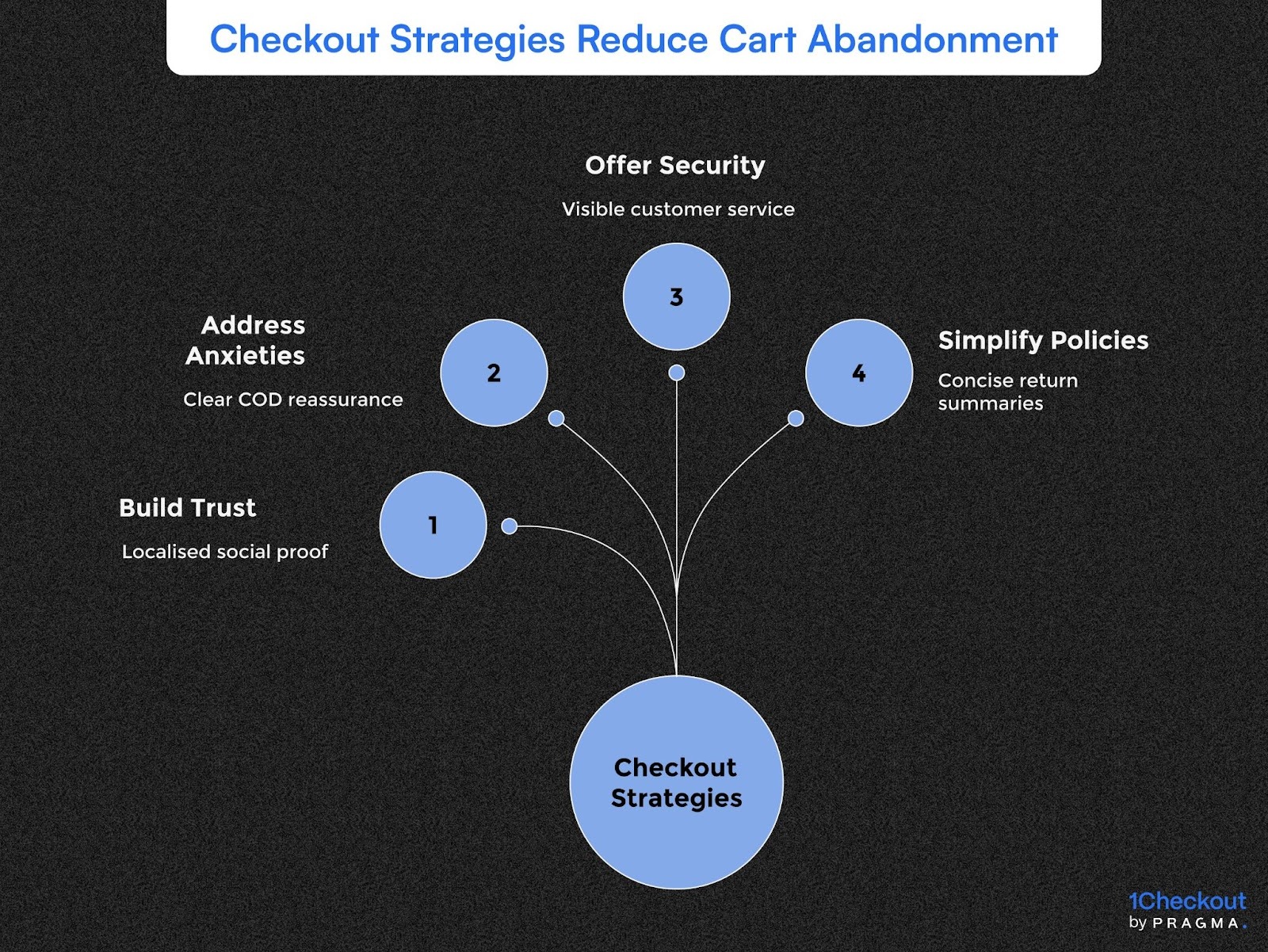
To effectively reduce cart abandonment in Tier-2 and Tier-3 cities, consider these key strategies for your checkout flow:
Build Trust with Localised Social Proof:
- Feature testimonials from customers in similar cities, using their local language.
- Highlight specific local contexts in reviews, such as "Delivered perfectly to Vijay Nagar area" or "Great quality, I'm from Civil Lines," to create geographic relevance. This directly addresses concerns like "will this work for me in my city?"
Address Cash on Delivery (COD) Anxieties Directly:
- Prominently display reassurance messages near payment selection.
- Clearly state "Inspect product quality before paying courier," "No advance payment required," and "Return easily if product doesn't match expectations." These explicit statements resolve common COD concerns, moving them beyond legal disclaimers to decision-relevant information.
Offer Psychological Security with Visible Customer Service:
- Provide customer service phone numbers with clear click-to-call functionality.
- Even if not used, the presence of an easily accessible number builds comfort, assuring customers that problems can be resolved through familiar voice channels, aligning with cultural communication preferences.
Simplify Return and Exchange Policies at Checkout:
- Instead of linking to lengthy policy pages, present concise summaries in simple language.
- Inline statements like "15-day return period," "Free size exchange," and "Full refund if damaged" provide essential information directly, acknowledging concerns while demonstrating brand confidence in product quality.
Measuring Tier-2/3 Checkout Performance

To Wrap It Up
Checkout optimisation for Tier-2 and Tier-3 markets requires acknowledging that these aren't simply "metros with slower internet" but distinct environments with different infrastructure realities, cultural contexts, and transaction preferences. The technical, linguistic, and psychological adaptations needed represent opportunities to serve underserved markets rather than compromises diluting metro experiences. Smart architecture enables both markets simultaneously through responsive design that detects and adapts to user context.
Run five user testing sessions with actual customers from your target Tier-2 and Tier-3 cities, watching them attempt checkout on their own devices and networks, documenting every hesitation, confusion point, and abandonment trigger you observe.
Long-term success in non-metro markets demands treating regional adaptation as core product strategy rather than post-launch afterthought. Brands building Tier-2/3 considerations into initial design processes—questioning every field's necessity, testing on constrained devices and networks, validating with representative users—create experiences that work excellently across all markets.
The inclusive design approach serves broader audiences better whilst avoiding the retrofit complexity of optimising metro-first products for markets they weren't designed to serve. The effort compounds into sustainable competitive advantages as non-metro markets drive India's next wave of e-commerce growth.
For D2C brands seeking to unlock Tier-2 and Tier-3 market potential through optimised checkout experiences, Pragma's adaptive checkout platform provides network-aware performance optimisation, regional language support, payment method flexibility, and progressive enhancement architecture that help brands achieve 58-67% conversion improvement in non-metro markets whilst maintaining metro performance through intelligent context detection and experience adaptation.

FAQs (Frequently Asked Questions On How to Build a Checkout Flow That Reduces Cart Abandonment in Tier-2 & Tier-3 Cities)
1. Why do customers in Tier-2 and Tier-3 cities abandon their shopping carts more often?
Cart abandonment in these cities often occurs due to poor user experience, lack of trusted payment options, complicated checkout processes, high shipping costs, or concerns about delivery reliability — especially for non-urban regions.
2. How can I design a checkout flow that encourages completing purchases in rural and semi-urban markets?
Simplify the checkout process, minimise form fields, offer regional language support, highlight trusted payment methods like UPI or cash, and clearly communicate delivery timelines and costs to reduce friction and build trust.
3. What payment options are most effective for Tier-2 and Tier-3 city customers?
UPI-based payments, cash on delivery (COD), and local wallet options are preferred in these regions. Offering multiple trusted options helps reduce cart abandonment and enhances conversion rates.
4. How important is delivery trustworthiness in reducing cart abandonment in regional markets?
Very important. Customers need confidence that their orders will be delivered on time and intact. Clear communication about delivery tracking, regional logistics partners, and return policies helps build trust and increases conversions.
5. How can data analytics help optimise the checkout flow specifically for Tier-2 & Tier-3 cities?
Data insights on regional payment preferences, peak shopping times, preferred delivery slots, and common cart drop-off points enable brands to customise and simplify the checkout experience for these markets, improving overall conversion.


